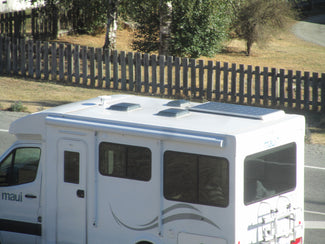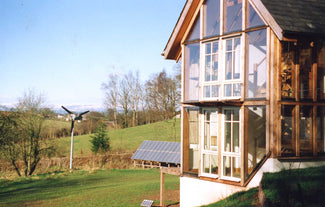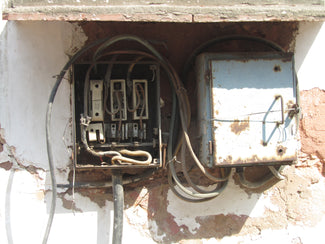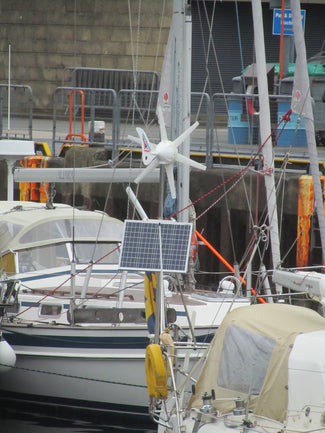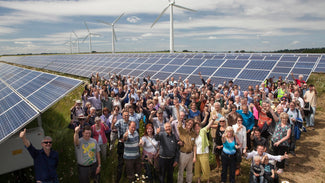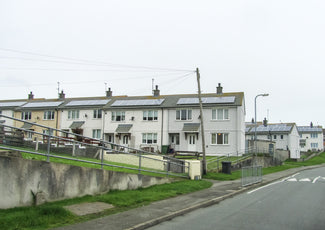Extra Income For Rural Businesses
Becoming an energy generator is the ideal diversification for farms or landholding organisations:
- Reduce high energy costs;
- Future-proof your business against rising prices;
- Give you a viable, profitable investment;
- Provide a predictable index linked source of income
- Generate free electricity for typically well over 30 years!
Roof Mounted Solar Systems

Solar panels can be installed on almost any suitably constructed roof - farmhouse, barn, or outbuildings, - slate, tile, metal and fibre cement. A structural inspection will be required to check load bearing capabilities and it is important that the roof itself will last for the lifetime of the PV system (typically 30 years). Unshaded, south facing roofs are best.
Planning permission is not usually required for roof mounted systems unless your property is a listed building or is sited in a conservation area, National Park or other environmentally sensitive area.


Ground Mounted Solar Systems

Solar panels can be fitted on ground mounted structures in fields configured to allow on-going land use, such as for free range poultry or grazing sheep. The usual site for a ground mounted system is in a flat field with an open southerly aspect.
Ground mounted systems will need planning permission.


Connection to the Grid

Even small farms with just a single phase supply can take advantage of installing renewable energy generating systems. However, most farms have a good 3-phase electricity supply which allows for larger systems (10kW and above) to be installed with minimal cost or consultations with the electricity network company.
Your installer can investigate the options with your electricity network provider.
You can maximise the benefits from your PV system by using as much as possible of the power you generate on your farm. Control systems are available to help with this.


Livestock Watering and Irrigation

While it’s not unusual for farmers to let their animals drink from a stream, pond, or other surface water source, many are switching to alternative methods of supplying drinking water to their livestock.
Keeping livestock away from watercourses can protect water quality and help reduce river bank erosion. Solar powered water pumps can be used to help with this. They are easy to install and are a very reliable way to pump water from a well to a ground-level tank or water trough, or from a surface source of water up to a higher elevation. They can be located in an abstraction chamber in the water source and water pumped to a trough during hours of daylight which then acts as temporary storage. Performance is best in summer which often closely matches livestock requirements.
In some areas grants are available to fence off grazing lands from nearby streams and install an alternative means of water provision, which can include solar-powered pumping solutions.


Remote Farm Buildings

Wind or solar battery charging systems can be the ideal solution for remote buildings that need power for lighting or appliances.
Smaller systems use 12V lighting and equipment run directly from a battery, with the wind or solar charging sized to keep up with anticipated demand. Inverters can be included to enable 230 Vac ‘mains’ power to be provided, enabling conventional tools or appliances to be run.
The simplest systems use a photovoltaic (PV) solar panel to recharge the battery. This can be easily fitted to the roof or a sunny wall of the building. Greatest output will be over summer months so this is ideal for holiday, weekend or garden buildings. No moving parts are involved so such systems are almost maintenance free. For year round use wind generators are ideal for providing lighting since maximum output tends to be over winter when lighting is needed most. Small wind generators can often be easily mounted on the end of a building using TV aerial type brackets and pole. Power is fed down to the battery via a charge controller and then on to the loads. In sheltered locations where using wind power is not feasible, additional PV panels to increase winter output helps year round performance. For buildings with greater power requirements larger systems or combined wind/solar systems can be designed, allowing an economical alternative to bringing in the mains.


Solar Powered Electric Fencing
Solar PV panels are the ideal way to maintain the charge in 12V batteries used to run electric fencing units. Usually a 10Wp PV panel will suffice. Bigger panels may be necessary where there is heavy use in winter. What to use can easily be determined if it is known how long the battery can last in normal use between charges. Alternatively, electric fencing is commonly an extra load in stable lighting systems.
